Writing Samples - Web Articles
Around the World in One Year – Part 5
Grand Valleys in Europe
The second half of our trip around the world was dedicated to relaxed exploration of selective areas and cities in Western Europe. Aside from obvious favorites like Rome, Paris, Tuscany, and the Alps, we discovered a few “hidden valleys” with surprising landscapes and sights.
The Moselle Valley in Germany
The Moselle River valley offers just as much charm, good wine, and “castleseeing” as the legendary Rhine. Narrower and slower, the Moselle curls around hilly cliffs, many of them used to grow vines (left). Our room for the night on a working vineyard estate looked out onto the river, the barges and cruise ships gliding on the smooth surface, and the green vines on the other side. The room price included a bottle of the house wine.
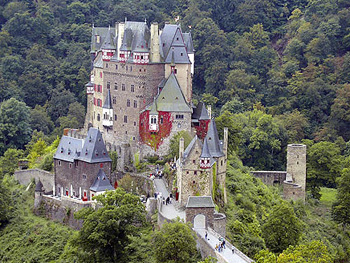
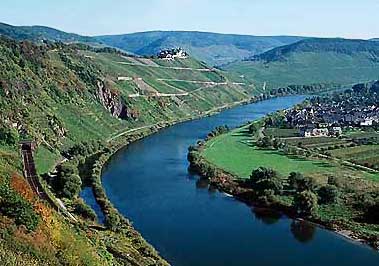
We left early morning for our hike to Burg Eltz, in many eyes the most beautiful castle in the Rhine/Moselle area. Dense forest hides the castle for most of the two-hour hike. Then suddenly, high above the trail, the fairytale castle magically appears (above right). Like a Disney movie set, the majestic building stands on a large rock formation in the U-bend of a small river. The Eltz family received the castle in 1157 and still holds the ownership. Construction continued throughout the centuries, so various architectural styles stack on top and next to each other. The flawless interior exhibits fine artwork and priceless household objects one would expect to find in a major museum. After an educational three-hour tour, we started on a leisurely hike back, turning often to behold the grand view until the trees closed the curtain.
The Loire Valley in France
After ten exhausting days in Paris, which impressed us with its glamour and sophistication, we found our real love for France amongst the gentle rolling hills, golden fields, and magical castles of the Loire valley. Kings and noblemen built grand fortifications, palaces, and villas along the rivers Loire and Cher as a testament to outrageous wealth and power. Some have fallen to ruin, but many remain to transport us back to the times of knights, chivalry, and nobility.
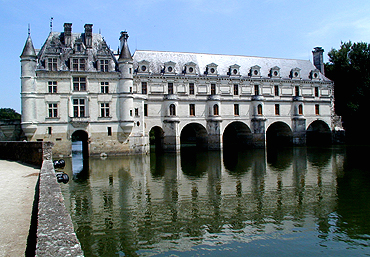 The visit to Chambord, a huge castle commissioned by Francis I upon his return from Italy, initiated our unquenchable thirst for the history of this time period. The building's architectural style reflects the king’s desire to bring the Italian renaissance to France. Historians suggest that the main spiral staircase was designed by Leonardo da Vinci, who spent his last years nearby at Amboise. Like a strand of DNA, the staircase rises in two separate spirals. This allows the passage of two people without ever meeting, though one can see the other pass looking through windows in the central column.
The visit to Chambord, a huge castle commissioned by Francis I upon his return from Italy, initiated our unquenchable thirst for the history of this time period. The building's architectural style reflects the king’s desire to bring the Italian renaissance to France. Historians suggest that the main spiral staircase was designed by Leonardo da Vinci, who spent his last years nearby at Amboise. Like a strand of DNA, the staircase rises in two separate spirals. This allows the passage of two people without ever meeting, though one can see the other pass looking through windows in the central column.
Chenonceau (left) is the most visited, and perhaps the most beautiful, of all the castles. It spreads across the gentle river Cher, connecting its sides like a bridge and creating surreal reflections. Blooming gardens complement each other on both sides of the entrance.
W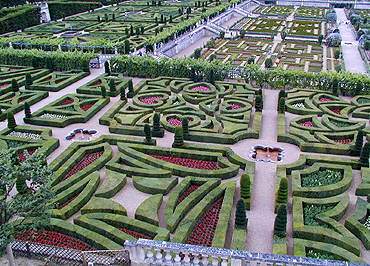 e encountered the most memorable garden designs at the grounds of Villandry (right). A brilliant Spanish physician gave up his medical career to save this palace from ruin. On the grounds he assembled a remarkable collection of vegetable, flower, tree, and bush varieties into linear and geometric patterns. Each section incorporates different designs, which, as a whole, achieve beautiful unity.
e encountered the most memorable garden designs at the grounds of Villandry (right). A brilliant Spanish physician gave up his medical career to save this palace from ruin. On the grounds he assembled a remarkable collection of vegetable, flower, tree, and bush varieties into linear and geometric patterns. Each section incorporates different designs, which, as a whole, achieve beautiful unity.
The halls and parks of the castles along the Loire set the stage for romantic fairytales. Visit this enchanting area and write your own happy endings!
The Picos de Europa in Spain
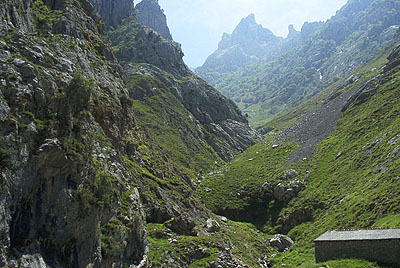
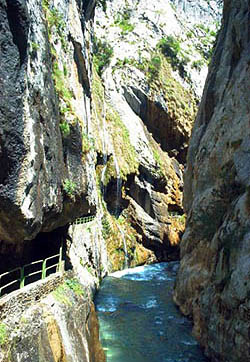 Tiny roads through steep river gorges lead into Picos de Europa (Peaks of Europe) National Park, which encompasses the highest peaks (about 10,000 feet) of the Cantabrian Range. We stayed in a charming hotel in Arenas de Cabrales and prepared for a hike along the Rio Cares on a famous trail between the area's majestic peaks (above).
Tiny roads through steep river gorges lead into Picos de Europa (Peaks of Europe) National Park, which encompasses the highest peaks (about 10,000 feet) of the Cantabrian Range. We stayed in a charming hotel in Arenas de Cabrales and prepared for a hike along the Rio Cares on a famous trail between the area's majestic peaks (above).
Beautiful weather during our seven-hour hike gave us the opportunity to appreciate the full splendor of this rugged, steep terrain. The trail leads across shaky footbridges and often edges 600-foot drops, challenges with aggressive ascents and descents, and disappears into tunnels cut into the mountain face (right). The steepness of the valley walls emphasizes the river’s roaring tune. Next to the walking trail, an ancient stone-lined canal brings fresh mountain water to the villages below.
We stretched out on a blooming meadow in the village of Cain and enjoyed some local bread and cheese. The return along the same trail provided very different views, with the sun now illuminating the opposite mountain face. Clean air, fresh water, and crisp views—the Picos de Europa hold a breath of purity among the crowded landscapes of Europe.
The Duoro Valley in Portugal
The Douro is a valley, it is a river, it is a vineyard, it is wine. The city of Porto, situated on both banks of the river, gave port wine its name. Visiting a few of the famous port wine lodges in Porto, we discovered the procedures of making and the pleasures of drinking this intoxicating beverage.
Port is a sweet fortified wine, exclusively produced in the Douro-designated region, and aged and bottled in Porto. The grape juice is fermented and then "arrested" with brandy to retain some of the natural sugar, which gives port its characteristic sweetness. Port is produced in a variety of different styles ranging from light, dry, white port to the quintessential vintage port.
We were curious to see the vineyards that produce the grapes for this delicious elixir. Our guide at the Sandeman lodge gave us directions for an easy highway route. The campground manager suggested we take the scenic drive along the Rio Duoro. Choosing the latter introduced us to romantic rural landscapes along the river, but unfortunately engaged us in an often-dangerous ride on windy, broken, extremely narrow roads.
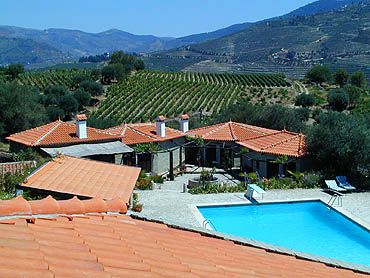 After seven hours, and several incorrect deviations, we arrived in wine country, ready to secure a hotel room at any price. But even the first-class Vintage Hotel had no vacancy. The concierge offered a fortunate alternative and sent us to a B&B property nearby. We reached the village of Chanceleiros after a twenty-minute climb through vineyard terraces. Behind the luxurious main villa of the hotel estate, six slate-stone buildings with nine guest rooms, a bar, and roofed sitting areas encircle an inviting pool (left). The structures fall away from the main house like a cascading waterfall. Olive trees, flowers, and blooming bushes complete this harmonious Garden of Eden. Beyond the property, the eyes wander up and down low mountains, carved with the parallel lines of terraced vineyards, sparkling with the saturated green of vine leaves.
After seven hours, and several incorrect deviations, we arrived in wine country, ready to secure a hotel room at any price. But even the first-class Vintage Hotel had no vacancy. The concierge offered a fortunate alternative and sent us to a B&B property nearby. We reached the village of Chanceleiros after a twenty-minute climb through vineyard terraces. Behind the luxurious main villa of the hotel estate, six slate-stone buildings with nine guest rooms, a bar, and roofed sitting areas encircle an inviting pool (left). The structures fall away from the main house like a cascading waterfall. Olive trees, flowers, and blooming bushes complete this harmonious Garden of Eden. Beyond the property, the eyes wander up and down low mountains, carved with the parallel lines of terraced vineyards, sparkling with the saturated green of vine leaves.
In the evening, our hostess Adelaide and her staff prepared a delightful meal for the guests. We sat on the verandah with an international crowd; watched a gigantic, orange full moon rise over the mountains; and ate, drank, and talked until 2:00 A.M. A memory so sweet and divine, just like the area’s famous wine!
Not even a lifetime of travels would allow thorough exploration of Europe’s treasures. We enjoyed the luxury of leaving behind the congested cityscapes and tourist hotspots to find the quiet life, the fresh air, the protected splendor. We will always draw from the memories and knowledge gathered during this year of travels. One lesson will travel with us in the future: Dare to stray from the beaten path, even get lost, because the best surprises wait around the corner! Happy travels!